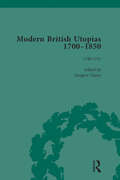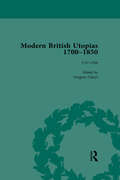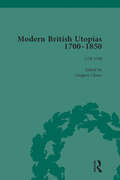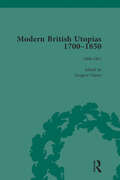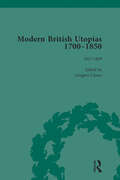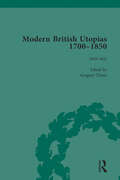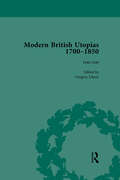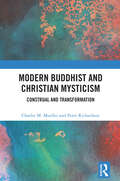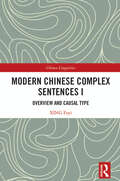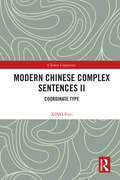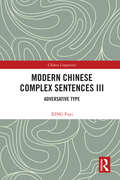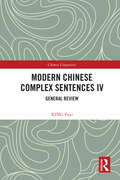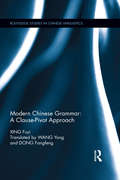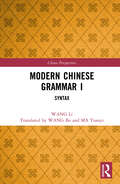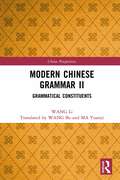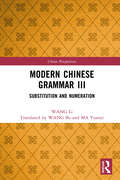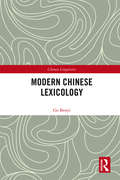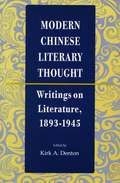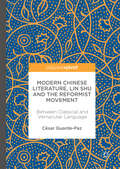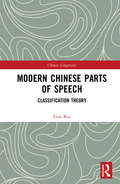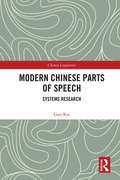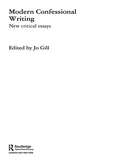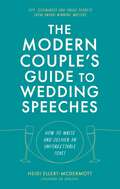- Table View
- List View
Modern British Utopias, 1700-1850 Vol 2
by Gregory ClaeysIn the period 1700-1850, the history of utopian thought cast light on ideas of property-holding, community, and social and political reform movements, including those for the extension of rights to slaves, women and animals. This text includes some of the best-known tracts of the period.
Modern British Utopias, 1700-1850 Vol 3
by Gregory ClaeysIn the period 1700-1850, the history of utopian thought cast light on ideas of property-holding, community, and social and political reform movements, including those for the extension of rights to slaves, women and animals. This text includes some of the best-known tracts of the period.
Modern British Utopias, 1700-1850 Vol 4
by Gregory ClaeysIn the period 1700-1850, the history of utopian thought cast light on ideas of property-holding, community, and social and political reform movements, including those for the extension of rights to slaves, women and animals. This text includes some of the best-known tracts of the period.
Modern British Utopias, 1700-1850 Vol 5
by Gregory ClaeysIn the period 1700-1850, the history of utopian thought cast light on ideas of property-holding, community, and social and political reform movements, including those for the extension of rights to slaves, women and animals. This text includes some of the best-known tracts of the period.
Modern British Utopias, 1700-1850 Vol 6
by Gregory ClaeysIn the period 1700-1850, the history of utopian thought cast light on ideas of property-holding, community, and social and political reform movements, including those for the extension of rights to slaves, women and animals. This text includes some of the best-known tracts of the period.
Modern British Utopias, 1700-1850 Vol 7
by Gregory ClaeysIn the period 1700-1850, the history of utopian thought cast light on ideas of property-holding, community, and social and political reform movements, including those for the extension of rights to slaves, women and animals. This text includes some of the best-known tracts of the period.
Modern British Utopias, 1700-1850 Vol 8
by Gregory ClaeysIn the period 1700-1850, the history of utopian thought cast light on ideas of property-holding, community, and social and political reform movements, including those for the extension of rights to slaves, women and animals. This text includes some of the best-known tracts of the period.
Modern Buddhist and Christian Mysticism: Construal and Transformation
by Charles M. Mueller Peter RichardsonInvestigations of mysticism often focus on the past while largely ignoring current developments.This book contributes to a reversal of that trend with a rigorous examination of a wide selection of contemporary Buddhist and Christian authors. The focus is on the intriguing intersections and subtle divergences now emerging in areas such as ineffability, nonconceptuality, paradox, inverted agency, unity, and self-dissolution. The analysis combines the theoretical framework of Cognitive Linguistics with a range of methodological approaches, from discourse and thematic analysis to corpus linguistics.Wide-ranging, systematic, and informative, the book is invaluable to all of those interested in the phenomenon of mysticism within the modern world.
Modern Chinese Complex Sentences I: Overview and Causal Type (Chinese Linguistics)
by XING FuyiThis book is the first of a four-volume set on modern Chinese complex sentences, and is focused on the overall characteristics and the casual complex sentences in the language in particular. Complex sentences in modern Chinese are unique in information and meaning. The author proposes a tripartite classification of Chinese complex sentences according to the semantic relationships between the clauses, that is, coordinated, causal, and adversative. The first part of this volume defines Chinese complex sentences, introduces the properties, scope, and functions of complex sentence relationship markers, and makes detailed comparisons between the tripartite and dichotomous systems for the classification of complex sentences. The second part thoroughly investigates causal complex sentences in their eight typical forms. The book will be a useful reference for scholars and learners interested in Chinese grammar and language information processing.
Modern Chinese Complex Sentences II: Coordinate Type (Chinese Linguistics)
by XING FuyiThis book is the second volume of a four-volume set on modern Chinese complex sentences, with a focus on coordinate complex sentences and their relevant forms.Complex sentences in modern Chinese are unique in formation and meaning. The author proposes a tripartite classification of Chinese complex sentences according to the semantic relationships between the clauses, that is, coordinate, causal, and adversative. This volume analyzes the coordinated type in the broad sense and the relevant forms, including the representative form in which the clauses are juxtaposed with each other, paired and single occurrences of the connective yībiān, and various forms of successive, progressive, and alternative complex sentences, as well as the compound forms.The book will be a useful reference for scholars and learners interested in Chinese grammar and language information processing.
Modern Chinese Complex Sentences III: Adversative Type (Chinese Linguistics)
by XING FuyiThis book is the third volume of a four-volume set on modern Chinese complex sentences, with a focus on adversative complex sentences and relevant forms.Complex sentences in modern Chinese are unique in formation and meaning. The author proposes a tripartite classification of Chinese complex sentences according to the semantic relationships between the clauses, i.e., coordinate, causal, and adversative. This volume analyzes representative forms of adversative type, including the prototype, the clauses linked by connectives referring to otherwise, the combinations of clause structures and certain adversative conjunctions or linking adverbs indicating an adversative relationship, the adversative factors and relationship in two typical progressive structures, factive sentences and concessive forms. It also discusses the adversative type in the broad sense, classifying the different forms and also analyzing the semantic meaning, pragmatic value, and implications for research and language teaching.The book will be a useful reference for scholars and learners of the Chinese language interested in Chinese grammar and language information processing.
Modern Chinese Complex Sentences IV: General Review (Chinese Linguistics)
by XING FuyiThis book is the final volume of a four-volume set on modern Chinese complex sentences, assessing the key attributes, related sentence structures, and semantic and pragmatic relevance of complex sentences. Complex sentences in modern Chinese are unique in formation and meaning. Following on from analysis on coordinate, causal and adversative types of complex sentences, the ten chapters in this volume review the characteristics of complex sentences as a whole. The author discusses the constituents, related structures, semantic and pragmatic aspects of complex sentences, covering topics such as the constraints and counter-constraints between sentence forms and semantic relationships, six type-crossover markers, distinctions between simple sentences and complex sentences, clauses formed by a noun/nominal phrase followed by le, the shǐ-structure, subject ellipsis or tacit understanding of clauses, as well as double-subject sentences, alternative question groups and their relationships withcomplex sentences. The book will be a useful reference for scholars and learners interested in Chinese grammar and language information processing.
Modern Chinese Grammar - a Clause-Pivot Approach: A Clause-Pivot Theoretical Approach (Routledge Studies in Chinese Linguistics)
by Fuyi XingModern Chinese Grammar provides a comprehensive coverage of Chinese grammar through the clause-pivot theory and the double triangle approach, first proposed by Fuyi Xing in 1996. Translated into English for the first time, the book is widely regarded by linguists as a seminal text, and ground-breaking in linguistics research. The book contains discussion of the topics which are essential to Chinese grammar, from words and phrases, to complex sentences and sentence groups. It addresses such controversial issues as word class identification, the distinction between words and phrases, and between clauses and complex sentences. The book also shows, through a wealth of examples, how the clause-pivot theory and the double triangle approach can be applied productively in grammatical studies. Modern Chinese Grammar: A Clause-Pivot Theoretical Approach is an essential purchase for researchers and graduate students of Chinese grammar and syntax.
Modern Chinese Grammar I: Syntax (China Perspectives)
by WANG LiFocusing on the fundamental grammatical units and construction in modern Chinese, this title is the first volume of a classic on modern Chinese grammar by WANG Li, one of the most distinguished Chinese linguists. Based on the corpus of two classic Chinese novels and being part of a four-volume set that describes the various linguistic patterns of modern Chinese grammar, this volume first distinguishes Chinese characters from words, categorizes words into different word classes and discusses the different word classes according to the number of syllables. The complex structures, which include phrases, sentences and various grammatical constructions such as those of optative, causative, disposal, passive, annex and retrenched, are then classified and elaborated on. Drawing on Otto Jespersen’s theory, the author applies the notion of rank to construct a new framework for Chinese grammar. Including a wide variety of examples and analyses, this book is a must-read for Chinese language learners, as well as researchers and students studying Chinese linguistics and modern Chinese grammar.
Modern Chinese Grammar II: Grammatical Constituents (China Perspectives)
by WANG LiFocusing on the fundamental grammatical units and construction in modern Chinese, this title is the second volume of a classic on modern Chinese grammar by WANG Li, one of the most distinguished Chinese linguists. This volume discusses nine major grammatical components in modern Chinese: 1) copulas, 2) negation, 3) adverbs, 4) markers applied to indicate the features of words or phrases, 5) aspects that indicate the duration and status of events, 6) moods that help express the emotions in language, 7) modal tertiaries, 8) connectives and 9) relative tertiaries. Including a wide variety of examples and analyses, this book is a must-read for Chinese language learners, as well as researchers and students studying Chinese linguistics and modern Chinese grammar.
Modern Chinese Grammar III: Substitution and Numeration (China Perspectives)
by WANG LiFocusing on substitution and numeration of modern Chinese, this is the third volume of a classic on modern Chinese grammar by WANG Li, one of the most distinguished Chinese linguists. In this volume, the author first introduces the different types of pronoun, such as personal pronoun, indefinite pronoun, resumptive pronoun, demonstrative pronoun and interrogative pronoun. Methods of numeration in modern Chinese are then delineated, encompassing such perspectives as cardinal number, ordinal number and numeration system of person, thing and behavior. Including a wide variety of examples and analyses, this book is a must-read for Chinese language learners, as well as researchers and students studying Chinese linguistics and modern Chinese grammar.
Modern Chinese Grammar IV: Special Forms and Europeanized Grammar (China Perspectives)
by WANG LiFocusing on the special forms and Europeanized grammar of modern Chinese, this is the final volume of a classic on modern Chinese grammar by WANG Li, one of the most distinguished Chinese linguists. This volume deals with the special forms in modern Chinese grammar, covering topics such as 1) reduplicated syllable, reduplicated words and opposite term, 2) incorporation, combination and idiom, 3) onomatopoeia and scene-painting, 4) repetition, 5) continuation and omission, 6) inversion and parenthesis and 7) interjection. The latter part of the volume concentrates on the changes in modern Chinese grammar resulting from the influence of Western languages, with the following aspects of Europeanized grammar being explored: 1) the coinage of disyllabic words, 2) the increase of subjects and copulas, 3) the extension of sentence lengths, 4) the Europeanization of potential forms, passive forms, markers and connective constituents and 5) new methods of substitution and numeration. Including a wide variety of examples and analyses, this book is a must-read for Chinese language learners, as well as researchers and students studying Chinese linguistics and modern Chinese grammar.
Modern Chinese Lexicology (Chinese Linguistics)
by Ge BenyiCentring on "words" which connect vocabulary and semantic morphemes, this book makes a systemic and in-depth analysis on the study of modern Chinese lexicology. Firstly, it clarifies the definitions and properties of vocabulary, words and semantic morphemes in Chinese. Then the structure forms of Chinese words are examined. It is worth noting that this research is one of the first to distinguish word formation and lexical morphology. It observes that word formation studies how neologisms are coined, while lexical morphology refers to the ways in which semantic morphemes are combined with each other. On word meaning and its clustering, it discusses the relationship between word meaning and concept, as well as the criteria and principles of the clustering. Specifically, it studies monosemes, polysemes, synonyms, near-synonyms, antonyms, etc., including their characteristics and types. Lastly, it explores the evolution of word meaning and its laws, as well as the dynamic form of vocabulary. This book will be a valuable reference for scholars and students in linguistics, especially in Chinese lexical studies.
Modern Chinese Literary Thought: Writings on Literature, 1893-1945
by Kirk A. DentonThis volume presents a broad range of writings on literature from the period of the inception of literary modernity in China.
Modern Chinese Literature, Lin Shu and the Reformist Movement
by César Guarde-PazThis Pivot reconsiders the controversial literary figure of Lin Shu and the debate surrounding his place in the history of Modern Chinese Literature. Although recent Chinese mainland research has recognized some of the innovations introduced by Lin Shu, he has often been labeled a 'rightist reformer' in contrast to 'leftist reformers' such as Chen Duxiu and the new wave scholars of the May Fourth Movement. This book provides a well-documented account of his place in the different polemics between these two circles ('conservatives' and 'reformers') and provides a more nuanced account of the different literary movements of the time. Notably, it argues that these differences were neither in content nor in politics, but in the methodological approach of both parties. Examining Lin Shu and the 'conservatives' advocated coexistence of both traditional and modern thought, the book provides background to the major changes occurring in the intellectual landscape of Modern China.
Modern Chinese Parts of Speech: Classification Theory (Chinese Linguistics)
by Guo RuiWhat is the essence of a part of speech? Why is it difficult to classify parts of speech? What are the bases and criteria for classifying them? How should they be classified? In doing so, how should a conversional word be dealt with? How should nomonalization be treated? These are just some of the questions answered in this book. The classification of parts of speech in Chinese is a tough job due to the language's lack of morphological differences. Based on the analysis of nearly 40,000 Chinese characters, this book proposes that, essentially, a part of speech is not of distributional type and that its intrinsic basis is an expressional function and the semantic type. Essentially, large categories such as substantive words, predicate words and modification words are classes of words classified according to their expressional functions. Basic categories such as nouns, verbs and adjectives are classes that combine semantic types with syntactical functions. In classifying parts of speech, the book pays attention not to identifying a single distributive characteristic that is internally universal and externally exclusive but to clustering the grammatical functions that have the same classification value through the “reflection-representation” relationship among distribution, expressional function and semantic type (distribution reflects expressional function and semantic type, which are, in turn, represented as distribution), thereby identifying the classification criteria. It uses distributional compatibility and the correlation principle to analyze which distributional differences represent differences in parts of speech and which do not. In this way, grammatical functions that have equal classification values are collected into one equivalent function cluster, each of which represents one part of speech. The book uses four strategies to classify parts of speech, namely the homogeneity strategy, the homomorphical strategy, the priority homomorphical strategy and the consolidation strategy. It will be a valuable reference for Chinese linguistic researchers and students as well as Chinese learners.
Modern Chinese Parts of Speech: Systems Research (Chinese Linguistics)
by Guo RuiClassification of parts of speech in Chinese is tough due to the lack of morphological differences, and thus is short of in-depth investigation and exploration. Based on the analysis and research of nearly 40,000 Chinese characters, this book elaborates on the system of Chinese parts of speech and proposes a set of criteria on their classification, contributing to relevant theoretical and methodological studies. To begin with, it examines the common characteristics and internal hierarchies of parts of speech, as well as the relationship between grammatical functions and parts of speech in modern Chinese. Then it puts forward the criteria on the classification of Chinese parts of speech, with a descriptive explanation of around 20 parts of speech. Besides, it illustrates the statistical studies on Chinese parts of speech, offering data support and corpus verification to the criteria. Also, it analyses the system of Chinese parts of speech from the perspective of typology. Specifically, it elucidates the correspondence between syntactic positions and parts of speech, functional differentiation of Chinese word items, etc. This book will be a valuable reference to researchers and students in Chinese linguistics. Learners of Chinese will also be attracted by it.
A Modern Coleridge
by Andrea TimárA Modern Coleridge shows the interrelatedness of the discourses of cultivation, addiction and habit in Coleridge's poetry and prose, and argues that these all revolve around the problematic nexus of a post-Kantian idea of free will, essential to Coleridge's eminently modern idea of the 'human'.
Modern Confessional Writing: New Critical Essays (Routledge Studies in Twentieth-Century Literature #Vol. 2)
by Jo GillA comprehensive and scholarly account of this popular and influential genre, the essays in this collection explore confessional literature from the mid-twentieth century to the present day, and include the writing of John Berryman, Anne Sexton, Ted Hughes and Helen Fielding. Drawing on a wide range of examples, the contributors to this volume evaluate and critique conventional readings of confessionalism. Orthodox, humanist notions of the literary act of confession and its assumed relationship to truth, authority and subjectivity are challenged, and in their place a range of new critical perspectives and practices are adopted. Modern Confessional Writing develops and tests new theoretically-informed views on what confessional writing is, how it functions, and what it means to both writer and reader. When read from these new perspectives modern confessional writing is liberated from the misconception that it provides a kind of easy authorial release and readerly catharsis, and is instead read as a discursive, self-reflexive, sophisticated and demanding genre.
The Modern Couple's Guide to Wedding Speeches: How to Write and Deliver an Unforgettable Speech or Toast
by Heidi Ellert-McDermottGroom or bride, straight or gay. Nail the perfect words to say.There's no longer an excuse for wedding speeches to be a tedious succession of predictable platitudes, outdated etiquette and cheesy wedding gags. This book is for nearlyweds who want to make their wedding speeches one of the day's highlights.Written by Heidi Ellert-McDermott, award-winning wedding speechwriter and founder of Speechy, this guide will help you write and deliver a speech that's memorable for the right reasons.Heidi's advice has been quoted everywhere from the Daily Mail to the New York Times, and with insights and trade secrets from comedians, TV scriptwriters and wedding influencers, this is the ultimate toolkit for couples wanting to make their wedding speeches a little more wonderful.Create a lifelong memory as you: · Plan the perfect speech line up· Decide how to represent your union 'on mic'· Swot up on modern speech etiquette· Gather cracking content and curate your best material· Discover the simple speechwriter techniques that will help you develop unique, humorous and sentimental lines to add wit and depth to your speech· Learn the trade secrets to delivering like a pro · Get inspired by over a dozen wedding speech examples written by professional speechwriters
